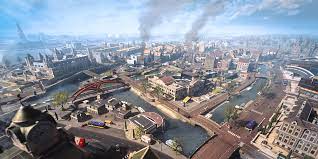Unveiling the Significance of r/DMZ: Safeguarding Network Security in the Digital Realm

Introduction
In the world of technology and networking, the term r/DMZ holds significant importance. The concept of r/DMZ refers to a demilitarized zone in the context of network security. It acts as a buffer zone between the internal secure network and the external untrusted network, providing an additional layer of protection against potential threats and unauthorized access. Understanding the intricacies of r/DMZ is crucial for ensuring the security and integrity of network systems.
What is r/DMZ?
In the realm of network security, the term r/DMZ refers to a demilitarized zone—a strategically isolated segment within a network architecture. This zone functions as a neutral ground, positioned between the internal secure network and the external untrusted network. Its primary purpose is to serve as a buffer, allowing specific types of data to traverse while obstructing unauthorized access to sensitive information.
The r/DMZ is a crucial component of network security infrastructure, providing an additional layer of protection against potential threats and vulnerabilities. It is commonly utilized to host public-facing services such as web servers, email servers, and FTP servers. By segregating these services into the r/DMZ, organizations can mitigate the risk of compromising their internal networks in the event of a security breach.
Understanding the intricacies of r/DMZ is essential for network administrators and security professionals tasked with safeguarding the integrity and confidentiality of their network systems. By implementing and maintaining a well-designed r/DMZ, organizations can effectively manage the flow of data, fortify their defense mechanisms, and uphold the security posture of their digital infrastructure.
How Does r/DMZ Work?
In the intricate framework of network architecture, the r/DMZ, or demilitarized zone, assumes a critical position between the internal network and the external network. Functioning as a strategic barrier, it serves as a gatekeeper that filters both incoming and outgoing traffic, permitting only authorized communication to traverse through its confines. This selective filtering mechanism is paramount in safeguarding the integrity and security of the network.
The primary purpose of the r/DMZ is to segregate and host public-facing services, such as web servers, email servers, and FTP servers. By isolating these services within the r/DMZ, organizations can effectively compartmentalize their network infrastructure, reducing the exposure of their internal network to potential security threats originating from the external network.
Furthermore, the strategic placement of public-facing services within the r/DMZ helps minimize the risk of a security breach affecting the internal network. In the event of a cyberattack targeting the public-facing services, the r/DMZ acts as a protective barrier, limiting the extent of the breach and preventing unauthorized access to sensitive information stored within the internal network.
Overall, the r/DMZ plays a pivotal role in fortifying the security posture of network architectures by serving as a robust line of defense against external threats. Its strategic positioning and selective filtering capabilities empower organizations to maintain a secure and resilient network environment, thereby safeguarding their critical assets and ensuring uninterrupted business operations.
Benefits of Implementing r/DMZ
Utilizing r/DMZ within network architecture offers a significant advantage in terms of bolstering security measures. This strategic approach involves isolating public-facing services within a distinct network segment, effectively creating a protective barrier that shields the internal network from external threats. By compartmentalizing these services, organizations can mitigate the risk of potential security breaches originating from the external network.
Moreover, r/DMZ facilitates enhanced network management and monitoring capabilities. Network administrators can devote their attention to securing the demilitarized zone without compromising the integrity of the internal network. This focused approach allows for more efficient oversight of security measures within the r/DMZ, ensuring that any vulnerabilities or suspicious activities are promptly addressed.
Types of r/DMZ Configurations
Organizations have the flexibility to implement various configurations of r/DMZ based on their unique security needs and network environment. These configurations, including single-homed DMZ, dual-homed DMZ, and screened subnet DMZ, offer distinct levels of security and functionality, providing organizations with options to tailor their setup according to specific requirements.
The single-homed DMZ configuration involves a single firewall separating the DMZ from both the internal and external networks. This setup provides a basic level of security by isolating public-facing services within the DMZ. However, it may lack additional layers of protection compared to other configurations.
In contrast, the dual-homed DMZ configuration features two firewalls, one between the internal network and the DMZ, and another between the external network and the DMZ. This setup enhances security by adding an extra layer of defense, isolating the internal network from both the DMZ and the external network.
Lastly, the screened subnet DMZ configuration employs a combination of routers and firewalls to create a screened subnet that acts as a buffer between the internal network and the external network. This configuration offers the highest level of security and functionality, providing comprehensive protection against external threats while facilitating controlled access to public-facing services.
Each r/DMZ configuration has its advantages and trade-offs, allowing organizations to select the most suitable option based on their security requirements, infrastructure complexity, and budget considerations. By carefully evaluating these configurations, organizations can implement an effective r/DMZ setup that aligns with their overarching security strategy and network architecture.
Best Practices for Securing r/DMZ
Securing the r/DMZ entails the implementation of a comprehensive set of security measures designed to protect the demilitarized zone from potential threats. To fortify the integrity of the r/DMZ, organizations must adhere to a series of best practices aimed at mitigating vulnerabilities and preventing security breaches.
One fundamental aspect of r/DMZ security is the deployment of firewalls, which serve as the first line of defense by regulating incoming and outgoing traffic. By configuring firewalls to filter traffic based on predefined rules, organizations can control access to the r/DMZ and thwart unauthorized attempts to breach its perimeter.
In addition to firewalls, organizations should leverage intrusion detection systems (IDS) to actively monitor network traffic within the r/DMZ for signs of suspicious activity or unauthorized access attempts. IDS alerts administrators to potential security threats, enabling swift intervention to mitigate risks and prevent potential breaches.
Access control lists (ACLs) play a crucial role in r/DMZ security by restricting access to authorized users and devices while blocking unauthorized entities from gaining entry. By meticulously managing access permissions and enforcing stringent access controls, organizations can minimize the risk of unauthorized access to sensitive resources within the r/DMZ.
Furthermore, regular security audits and assessments are essential for evaluating the effectiveness of existing security measures and identifying potential vulnerabilities or weaknesses within the r/DMZ. Through periodic audits, organizations can proactively address security gaps, implement necessary updates or patches, and reinforce the overall security posture of the r/DMZ.
By adhering to these best practices and implementing a robust security framework encompassing firewalls, intrusion detection systems, access control lists, and regular security audits, organizations can effectively safeguard the integrity of their r/DMZ and mitigate the risk of security breaches. These proactive measures are essential for maintaining a secure and resilient network infrastructure in today’s evolving threat landscape.
Challenges of Managing r/DMZ
While leveraging r/DMZ provides organizations with enhanced security benefits, managing and maintaining the demilitarized zone can present several challenges. These challenges often stem from factors such as network complexity, configuration errors, and compliance requirements, which can complicate the administration of the r/DMZ infrastructure.
One significant challenge organizations encounter is managing the inherent complexity of network configurations within the r/DMZ. As the demilitarized zone serves as a boundary between the internal network and the external network, ensuring seamless connectivity while maintaining stringent security measures can be inherently complex. Configuring firewalls, routing rules, and access control lists within the r/DMZ requires careful planning and meticulous attention to detail to prevent misconfigurations that could compromise security.
Additionally, organizations must contend with the risk of configuration errors that may inadvertently weaken the security posture of the r/DMZ. Human error, misconfigurations, or outdated security policies can create vulnerabilities within the demilitarized zone, potentially exposing critical assets to exploitation by malicious actors.
Furthermore, compliance requirements add another layer of complexity to managing the r/DMZ. Organizations operating in regulated industries must adhere to stringent compliance standards and frameworks, such as PCI DSS or HIPAA, which impose specific security requirements for protecting sensitive data within the r/DMZ. Ensuring compliance with these regulations while maintaining optimal security posture poses a significant challenge for organizations.
To overcome these challenges, organizations must adopt a proactive approach to network security and implement robust management practices for the r/DMZ infrastructure. This includes conducting regular audits and assessments to identify and address configuration errors, vulnerabilities, and compliance gaps. Continuous monitoring of network traffic and security events within the r/DMZ is also essential to detect and respond to potential security incidents promptly.
By implementing proactive security measures and adopting a vigilant approach to monitoring and maintenance, organizations can effectively mitigate the challenges associated with managing the r/DMZ and ensure the integrity and security of their network infrastructure.
Future Trends in r/DMZ Technology
As the landscape of cybersecurity threats undergoes constant evolution, the technology underpinning r/DMZ is poised to advance in tandem to address emerging challenges. Future trends in r/DMZ technology are likely to encompass several key developments aimed at bolstering security measures and enhancing threat detection capabilities.
One significant trend expected in the evolution of r/DMZ technology is the integration of artificial intelligence (AI) and machine learning (ML) algorithms for threat detection. These advanced technologies can analyze vast amounts of network data in real-time, enabling more accurate and proactive identification of potential security threats within the r/DMZ environment. By leveraging AI and ML capabilities, organizations can enhance their ability to detect and respond to sophisticated cyber attacks, such as zero-day exploits and advanced persistent threats.
Another emerging trend is the adoption of zero-trust security models within the r/DMZ architecture. Zero-trust principles advocate for a strict policy of verifying and validating every access request, regardless of the user’s location or network privileges. By implementing zero-trust security measures, organizations can enforce granular access controls and minimize the risk of unauthorized access to resources within the r/DMZ.
Furthermore, the future of r/DMZ technology is likely to see increased automation of security controls and processes. Automated security solutions can streamline routine tasks such as firewall rule management, security policy enforcement, and threat response, reducing the burden on IT teams and improving overall operational efficiency. Additionally, automated security controls can help organizations adapt rapidly to evolving threats and mitigate potential security risks within the r/DMZ environment.
In summary, future trends in r/DMZ technology are expected to revolve around the integration of AI and ML for threat detection, the adoption of zero-trust security models, and the implementation of automated security controls. By embracing these advancements, organizations can enhance the security posture of their r/DMZ infrastructure and effectively mitigate emerging cybersecurity threats in an ever-evolving threat landscape.
FAQs
1. What is the primary purpose of r/DMZ in network security?
The primary purpose of r/DMZ is to create a secure buffer zone that separates internal networks from external networks, thereby protecting sensitive data and resources from unauthorized access.
2. How does r/DMZ contribute to enhancing network security?
r/DMZ enhances network security by isolating public-facing services in a separate network segment, reducing the risk of security breaches and minimizing the impact of potential cyber threats on the internal network.
3. What are the key components of a typical r/DMZ configuration?
A typical r/DMZ configuration includes firewalls, intrusion detection systems, access control lists, and security policies that govern the flow of traffic between the internal network, the demilitarized zone, and the external network.
4. How can organizations overcome the challenges of managing r/DMZ?
Organizations can overcome the challenges of managing r/DMZ by implementing proactive security measures, conducting regular security audits, training staff on best practices, and staying informed about emerging cybersecurity threats.
5. What role does r/DMZ play in compliance and regulatory requirements?
r/DMZ plays a crucial role in compliance and regulatory requirements by providing a secure boundary between internal and external networks, ensuring that sensitive data is protected and access controls are enforced according to industry standards and regulations.



